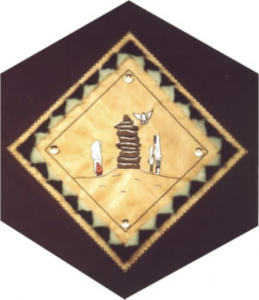Nunavik

The Block
This block, made by clothing designer Vicky Okpik, features an Inuit family around a largeInukshuk with an Okpik in the background. The human figures are sewn on tanned sealskin. A patterned border of sealskin, similar to the trim often seen on kamiks, frames four ivory ulus, the all-purpose tool of the Inuit woman. Kamiks (sealskin boots), parkas, and mittens are enduring items that continue to be handmade from natural skins in Inuit communities today. Comfortable and of exquisite quality, these articles of clothing have proven crucial for survival in the Arctic. Factory-made look-alikes in synthetic compounds simply cannot compare in terms of warmth, and are more likely to crack in the bitter cold.
Cultural Profile
The ancestors of the Nunavik of Northern Quebec and Labrador arrived along the shores of Hudson Bay, Ungava Bay, and Hudson Strait about four thousand years ago. They led a nomadic lifestyle, hunting and fishing to provide sustenance for their families. Contact with Europeans, who came to trade, hunt whale, and convert the Inuit to Christianity, had a deep influence on Inuit culture. Still, the Nunavik only began to settle into more permanent communities in the 1950s, when the Canadian government began to address the need for schools and infrastructure. Villages are small and isolated, often accessible only by airplane, making transportation costs very high. Major lifestyle changes and the tremendous challenges of living in the far north have made life for the Inuit a series of difficult adjustments.
The Nunavik were ingenious when it came to adapting to the harsh northern environment and climate. Using the surrounding, often scarce, natural resources they made warm clothing of unique design. They sewed together the skins of caribou, sealskins, walrus and polar bear skins with needles made of walrus ivory and sinew from animal tendons. Sealskin was preferable because it made great waterproof garments. They also used sealskin to cover the frame of their kayaks, another useful invention.
The extended family is the principal social unit of the Inuit community, which frequently includes adoptees, namesakes, in-laws, and co-residents. Many teens find they have to move south to attend secondary school. Prolonged separations from their family and tight-knit communities are difficult for many Inuit. Consequently, many choose to return home to familiar surroundings.
Their 14 communities have a current population of just over 9,000; 85% of whom still speak their native language, Inuktitut. Inuktitut is the language spoken by Inuit groups from Alaska to Greenland. The basic structure remains the same throughout all the different dialects. Despite drastic changes in the past five decades the Inuit have maintained a strong sense of their own identity and celebrate that identity as a community.
Sponsor: Makivik Corporation
